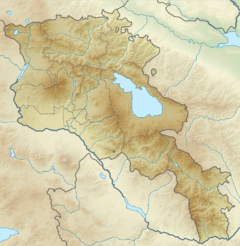Sevan Lake
| Lake Sevan | |
|---|---|

Aerial view of the lake
|
|

Lake Sevan is located in central eastern Armenia
|
|
| Location | Gegharkunik Province, Armenia |
| Coordinates | 40°19′N 45°21′E / 40.317°N 45.350°ECoordinates: 40°19′N 45°21′E / 40.317°N 45.350°E |
| Primary inflows | 28 rivers and streams |
| Primary outflows | evaporation: 85–90%, Hrazdan River: 10-15% |
| Basin countries | Armenia |
| Managing agency | Ministry of Nature Protection |
| Max. length | 74 km (46 mi) |
| Max. width | 32 km (20 mi) |
| Surface area | 1,242 km2 (480 sq mi) (2009) |
| Average depth | 25.9 m (85 ft) (2009) |
| Max. depth | 79.4 m (260 ft) (2009) |
| Water volume | 32.8 km3 (26,600,000 acre·ft) (2009) |
| Salinity | 0.7% |
| Surface elevation | 1,900.19 m (6,234.2 ft) (2012) |
| Islands | formerly 1 (now a peninsula) |
| Sections/sub-basins | 2 (Major Sevan, Minor Sevan) |
| Settlements | Gavar, Sevan, Martuni, Vardenis |
| Designations | |
|---|---|
|
IUCN Category II (National Park)
|
|
| Official name | Sevan National Park |
| Designated | 14 March 1978 |
| Designated | 6 July 1993 |
Lake Sevan (Armenian: Սևանա լիճ, Sevana lič̣) is the largest body of water in Armenia and the Caucasus region, and one of the largest freshwater high-altitude (alpine) lakes in Eurasia. The lake is situated in Gegharkunik Province, at an altitude of 1,900 m (6,234 ft) above sea level. The total surface area of its basin is about 5,000 km2 (1,900 sq mi), which makes up 1⁄6 of Armenia's territory. The lake itself is 1,242 km2 (480 sq mi), and the volume is 32.8 km3 (7.9 cu mi). It is fed by 28 rivers and streams. Only 10% of the incoming water is drained by the Hrazdan River, while the remaining 90% evaporates.
The lake provides some 90% of the fish and 80% of the crayfish catch of Armenia. Sevan has significant economic, cultural, and recreational value. Its only island (now a peninsula) is home to a medieval monastery.
Sevan was heavily exploited for irrigation of the Ararat plain and hydroelectric power generation during the Soviet period. Consequently, its water level decreased by around 20 m (66 ft) and its volume reduced by more than 40%. Two underground tunnels were later built to divert water from highland rivers, which halted its decline and its level began rising. Before human intervention dramatically changed the lake's ecosystem, the lake was 95 m (312 ft) deep, covered an area of 1,416 km2 (547 sq mi) (5% of Armenia's entire area), and had a volume of 58.5 km3 (14.0 cu mi). The lake's surface was at an altitude of 1,916 m (6,286 ft) above sea level.
The scholarly consensus is that the word Sevan originated from the Urartian word su(i)n(i)a, usually translated as "lake". The term is found on an 8th-century BC cuneiform inscription by the Urartian king Rusa I, found in Odzaberd, on the southern shore of the lake. Per folk etymology, Sevan is either a combination of sev ("black") + Van (i.e., Lake Van) or sev ("black") and vank’ ("monastery"). Russian and European sources of the 19th and early 20th century sometimes referred to the lake as Sevanga or Sevang. It is the Russified version of the Armenian sev vank’ ("black monastery") or, possibly, derives from the Armenian phrase սա է վանքը ("this is the monastery").
...
Wikipedia
